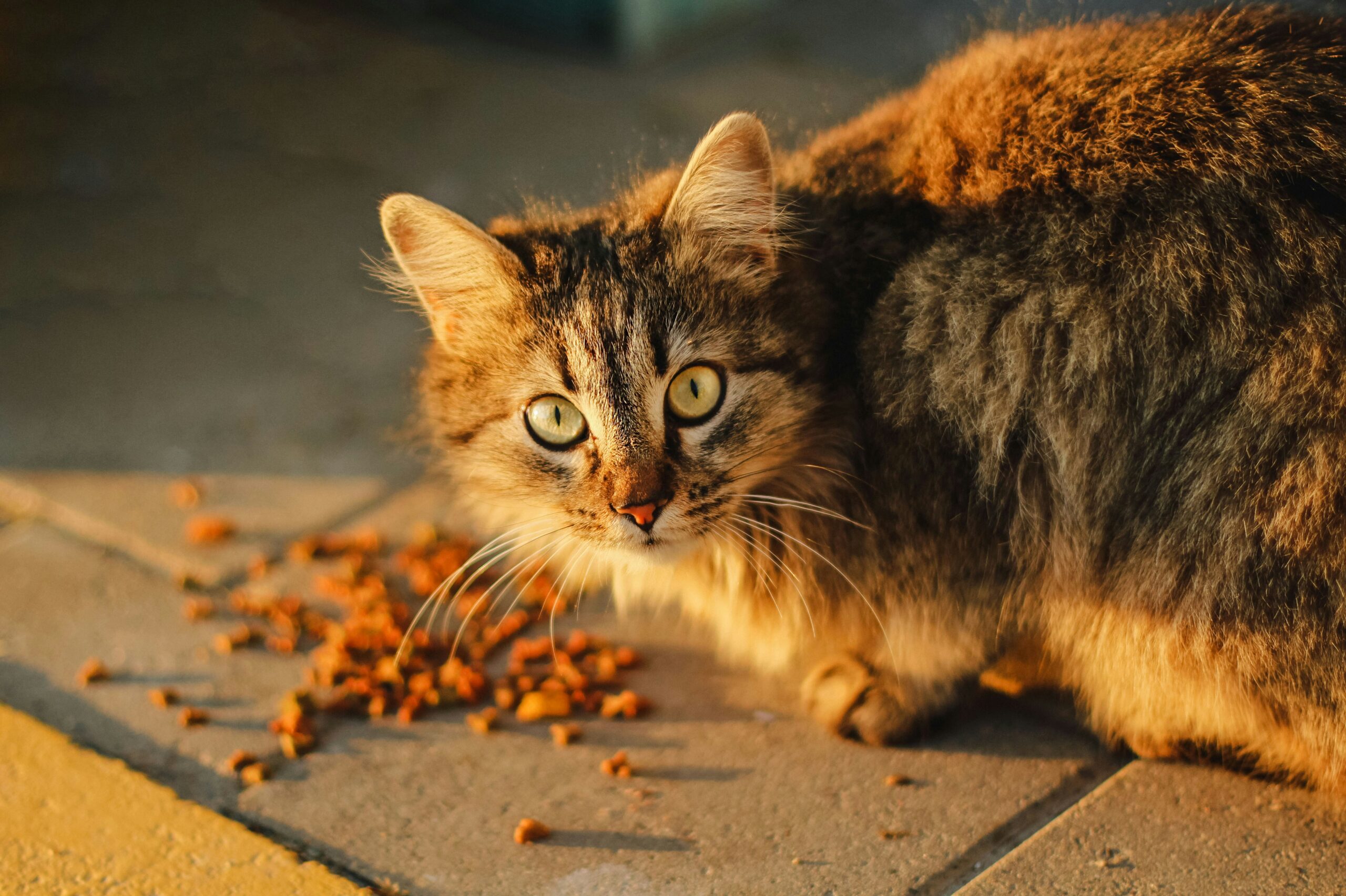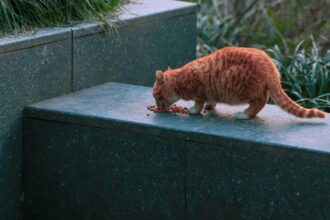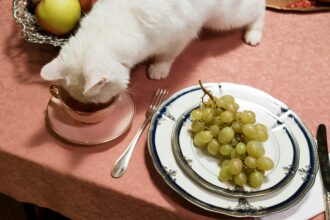When it comes to feeding your cat, choosing the right type of food is crucial for their health and well-being. Grain-free cat food has grown in popularity over the years, with many pet owners opting for it under the belief that it’s a healthier option for their cats. But is grain-free food truly the better choice, or is it simply a trend? In this article, we’ll explore whether grain-free cat food is really healthier for your feline friend and what factors you should consider when making this decision.
What is Grain-Free Cat Food?
Grain-free cat food is exactly what it sounds like: it contains no grains such as wheat, corn, soy, rice, or barley. Instead, these foods are often based on animal proteins like chicken, turkey, or fish, combined with vegetables like sweet potatoes, peas, and carrots to provide carbohydrates.
The idea behind grain-free diets is that cats, as obligate carnivores, don’t require grains in their diet. In the wild, a cat’s diet consists mostly of meat, with very little to no grains or carbohydrates. Many grain-free cat foods aim to mimic this natural diet by providing a higher percentage of animal-based protein and fats while eliminating grains altogether.
The Pros of Grain-Free Cat Food
- Potential Benefits for Cats with Food Allergies or Sensitivities
One of the main reasons pet owners choose grain-free food is because of food allergies or food sensitivities. Some cats are allergic to certain grains, which can lead to symptoms like vomiting, diarrhea, and itchy skin. By switching to grain-free food, pet owners can eliminate grains from their cat’s diet and potentially reduce these allergic reactions. Grain allergies in cats are relatively rare, but when they do occur, eliminating grains can lead to a noticeable improvement in their health.
- Better Digestion for Some Cats
Grain-free diets are often easier to digest for cats with sensitive stomachs or food intolerances. Grains are sometimes considered a more difficult ingredient for cats to digest, especially in large quantities. By feeding your cat grain-free food, you may improve digestion and reduce issues like bloating or gas, which are often caused by grains or other hard-to-digest fillers.
- Higher Animal Protein Content
Many grain-free foods are higher in animal-based proteins, which is closer to what cats would naturally eat in the wild. Cats are obligate carnivores, meaning they require a diet that’s rich in meat-based food. Higher protein levels help support muscle mass, energy, and overall growth, especially in kittens. Additionally, the high-protein content in grain-free diets can help with weight management, as protein is more satiating than carbohydrates and may help prevent overeating.
- Improved Coat and Skin Health
Since grain-free foods often contain more omega-3 fatty acids, which come from animal fats and fish oils, cats may experience healthier skin and coats. Omega-3 fatty acids are known for promoting healthy fur and reducing inflammation, which is beneficial for cats prone to skin conditions such as dry skin or dandruff.
- No Empty Carbohydrates
Grain-free foods tend to contain fewer empty carbohydrates found in grains like corn and wheat, which provide little nutritional value for cats. Cats don’t need grains for energy, so foods without these fillers may offer a more nutrient-dense option for your feline friend. This means more quality ingredients and fewer fillers, which can translate to a higher-quality diet.
The Cons of Grain-Free Cat Food
- Potential Link to Heart Disease (Dilated Cardiomyopathy)
While the idea of grain-free food may seem beneficial, there has been concern over the potential link between certain grain-free diets and dilated cardiomyopathy (DCM), a serious heart condition in cats. Some studies have suggested that grain-free foods, particularly those high in legumes like peas and lentils, could be contributing to a rise in DCM cases. This condition affects the heart muscle, making it weaker and less able to pump blood efficiently.
However, the exact cause of DCM is still being studied, and there is no conclusive evidence yet that grain-free food is the direct cause. Taurine, an amino acid that is essential for heart health, is often deficient in some grain-free diets, which may be contributing to the condition. As such, it’s important to choose high-quality grain-free foods that are properly formulated with sufficient taurine and other necessary nutrients.
- Not Always Nutritionally Balanced
Not all grain-free foods are created equal. Just because a food is grain-free doesn’t mean it’s automatically healthier. Some grain-free cat food options can still contain low-quality ingredients, such as fillers like peas, potatoes, or other starchy vegetables, which may not provide the necessary nutrients for your cat. In fact, these foods can sometimes be higher in carbohydrates than their grain-based counterparts, which is not ideal for an obligate carnivore.
It’s important to read the labels and ensure that the food you’re feeding your cat is nutritionally balanced and contains the right amount of protein, fat, and fiber, along with essential vitamins and minerals. Even in grain-free foods, it’s crucial to find products that are high in quality, with an appropriate balance of macronutrients for your cat’s specific needs.
- Not Suitable for Every Cat
While grain-free food can be beneficial for cats with specific food allergies or sensitivities, it’s not necessarily the best choice for every cat. Some cats may do perfectly well on a diet that includes grains, as grains can be a good source of fiber and carbohydrates. Cats with no known allergies or digestive sensitivities may not experience any significant benefits from switching to grain-free food. In fact, they may thrive just as well on a regular diet that includes grains.
- Cost
Grain-free cat food is often more expensive than traditional cat food that includes grains. The high-quality ingredients used in these diets, particularly animal proteins, can drive up the cost. If you’re on a budget, feeding your cat grain-free food could be a more expensive option, especially if you’re buying premium brands or feeding multiple cats.
- The Trend May Be Overhyped
There’s no denying that grain-free diets have become a trend in the pet food industry, and some pet owners may be feeding grain-free food because it’s popular, not necessarily because it’s the best choice for their cat. While grain-free food can be an excellent option for some cats, it’s important to remember that it’s not a magical solution for all health issues. For many cats, a balanced diet that includes grains, along with other essential nutrients, is sufficient for optimal health.
How to Choose the Best Food for Your Cat
When choosing cat food, whether grain-free or not, it’s essential to consider your cat’s individual health needs. Here are some factors to keep in mind:
- Allergies or Sensitivities: If your cat has food allergies or sensitivities, grain-free food may be a good option. However, it’s important to work with your veterinarian to identify the specific allergens and find a food that works best for your cat.
- Age and Activity Level: Kittens, senior cats, and active cats may have different nutritional needs. For example, kittens may require a higher calorie intake, while senior cats might benefit from weight loss food or low-calorie food. Consider your cat’s age and lifestyle when selecting food.
- Quality of Ingredients: Look for cat food that uses high-quality, meat-based food, with animal proteins as the first ingredient. Avoid foods with fillers like corn, wheat, or low-quality meat by-products.
- Health Conditions: If your cat has specific health concerns, such as a sensitive stomach or weight issues, you may need to choose a specialized diet. There are prescription foods and high-fiber foods designed to address particular health conditions, and your vet can guide you toward the best option.
- Consult Your Vet: Ultimately, the best way to determine whether grain-free food is right for your cat is to consult your veterinarian. They can provide personalized advice based on your cat’s health, age, and dietary needs.
Conclusion
Grain-free cat food may be a healthier option for cats with certain food allergies, sensitivities, or digestive issues. However, it’s not a one-size-fits-all solution, and it may not be necessary for every cat. It’s essential to consider your cat’s individual needs, including their health, activity level, and any food allergies, when choosing the right food. Always look for high-quality products that provide balanced nutrition, and don’t be swayed by trends without understanding your cat’s specific requirements. Ultimately, whether you choose grain-free or traditional food, the key is to provide your cat with a balanced, nutritious diet that supports their long-term health and happiness.







